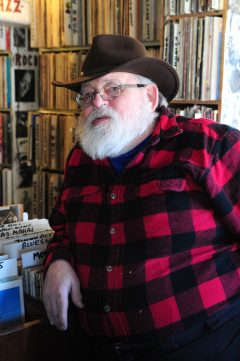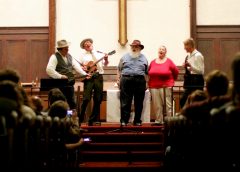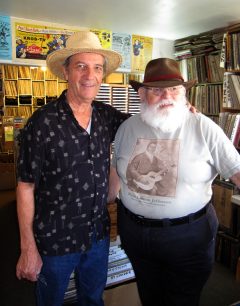Recordially, Lou Curtiss
The Sign of the Sun
Harold Darling opened the Sign of the Sun bookstore at Adams and College Ave. in San Diego sometime around 1960, catering to the students of San Diego State (then College) with used textbooks and magazines of a political and artistic bent, It was the time of folk music’s all-too-brief tie up with the pop music world, and Harold, not exactly approving, put in a stock of the more traditional types of records of the time (on labels like Folkways, Orgin Jazz Library, Riverside, and Prestige) and hired people to work at his store who had a traditional bent in both the arts and music.
A traditional music concert series was the inevitable result and over the next few years the store presented a wide variety of traditional performers including Mississippi John Hurt, Jean Ritchie, Ramblin’ Jack Elliott, Rev. Gary Davis, Bessie Jones, Rosalie Sorrells, Guy Carawan, Hedy West, Skip James, the New Lost City Ramblers, Sonny Terry and Brownie McGhee, Jean Redpath, Rita Weill, Fred MacDowell, Mike Seeger, and many others. Along with the traditional people from out of town, Harold also gave local and not so well known West Coast traditional performers a place to play. (Like today traditional performers were sort of shut out of the local clubs in favor of folk artists with a more pop-oriented performing style). Heard at the Sign of the Sun were Larry Hanks with his then partner Roger Perkins, Kathy Larisch and Carol McComb, German songster Gunter Schmitz, the Scottsville Squirrel Barkers (with then 16 year old Chris Hillman), Jack and Marilyn Powell, Mason Williams, and still San Diego favorite Curt Bouterse.
Along with the Sign of the Sun and somehow attached to it was a big old boarding house in Hillcrest at the corner of Front and Beech Streets where a lot of the Sign of the Sun employees lived. It was a big old house that catered to musicians and folks with an artistic bent. Whenever he could, Harold Darling would get his musicians in town a few days early and allow them to rest and jam a little with some local folks before they played a concert. The musician would them be relaxed, alert, and comfortable, feeling good about where he was. The result was almost always an exceptional performance. Sometimes artists like Bessie Jones would come into town and stay for a month or more at a time and many of us who hung around the Sign and visited the Boarding House got to meet and know her. The Sign of the Sun had a second location downtown for mostly concerts but it wasn’t open very long.
Sometime in the mid ’60s, Harold Darling decided that traditional music had enough support, and that vintage movies and art film didn’t. He moved to La Jolla and opened a small theater and bookstore complex (the Unicorn) and San Diego’s only regularly scheduled traditional music and country blues concert series came to an end. Still, later, when movies had enough support Harold Darling opened the Green Tiger Press, reprinting the vintage out of print books they are still doing today.
Traditional Music has never been very good at blowing its own horn. That’s particularly so when the competition for the same gigs is the more contemporary types of music (striped shirt trios of the ’60s or today’s singer-songwriters) It’s always taken folks like Harold Darling who figure someone ought to be supporting things that are old-timey, whether it be music, arts, film, or music. Too bad there aren’t more like him in San Diego today. We could sure use a Sign of the Sun today. We could also use some folks that are willing to put a little energy into bringing traditional folks to San Diego. It’s no way to get rich, and sometimes it’s a pain in unspoken parts, but you get to hear a lot of great music and you get to feel like you’ve done something for it and you get to meet some of the greatest folks you’ll ever get a chance to meet and that should be reason enough.
Recordially,
Lou Curtiss
Reprinted from the April 2012 issue of the San Diego Troubadour
Lou Curtiss Remembrance and Celebration
A memorial for Lou Curtiss will be held on Sunday, November 18 from 4-8pm at the Royal Palace Banquet Hall in El Cajon, the same building that once was the legendary Bostonia Ballroom. Lou Curtiss passed away at his home on July 9 of this year.
Lou had long wanted to host an event at the former Bostonia Ballroom space. We’ll be honoring both his wishes and this historic space, which hosted just about every country music star of the 1950s and ’60s. And we’ll also be honoring the unparalleled life and legacy of Lou Curtiss, who, at the age of 12, was lucky enough to see Hank Williams perform at the Bostonia.
The format for the event will be an open mic music-making festival, in which anyone is invited to sign up to perform a song or two in honor of Lou and/or the Bostonia. Please bring your instruments. You can also feel free to share some stories instead of performing a song. Parking is widely available at the venue. This is a potluck celebration of life, so please feel free to bring a dish. Beverages will be for sale at the venue.
We hope that many people will want to attend this one-of-a-kind event. I’m sure Lou will be smiling down on us, as we have finally organized something special at the old Bostonia Ballroom. This event is free and open to the public.
Musician Deke Dickerson will be presenting a half-hour talk about the history of the Bostonia Ballroom, while showcasing his collection of rare color photos of country legends playing at this historic venue.
Sunday, November 18, 4-8pm
Royal Palace Banquet Hall
1340 Broadway, El Cajon
******************
An Appreciation from Tom Brosseau
My name is Tom Brosseau. I’m a songwriter, singer, and touring musician. I got to know Lou pretty much right away when I moved to San Diego, in 2001. He made me a mixed tape of bygone era spooky and scary songs. I don’t recall how exactly we settled upon that theme. At Lou’s suggestion perhaps. When it was ready for pick up, I was surprised to find a page of liner notes accompanying the tape, which were extensive in detail. The names of the recording artists, years the songs were released, even the record labels that released them. What’s more, the liner notes were written longhand by Lou. What a true folk way. It’s an honor to share a memory on Lou, and it is equally an honor to have it published in the very column he established for the San Diego Troubadour, “Recordially.”
Lou spent much of his time digitizing live recordings from the San Diego folk celebrations he founded and helped book. The San Diego State Folk Festival, the Adams Avenue Roots Festival, and the Adams Avenue Street Fair. These celebrations span 40 years. Just think of it–that’s a lot of recordings! Song by song, festival year by festival year, Lou transferred these sonic artifacts himself. It was what kept him occupied while retired and at home with Virginia, his wife, in Granite Hills, California, and no doubt when he passed away his work was far from completed.
A story about one such recording, which Lou played for me and Gregory Page when we visited him at Folk Arts Rare Records in 2014. Back in the days of the 1960s folk revival, Lou took a trip to Angels Camp, California to visit Sara Carter of the original Carter family. Although he showed up at Sara’s residence unannounced, a complete stranger, he was welcomed in. Furthermore, Sara allowed him to conduct an interview, which Lou recorded on a portable reel to reel. Along with Sara’s husband, Coy Bayes, the three enjoyed a pleasant conversation about the autoharp method, over sandwiches and coffee. Lou would’ve been in his 20s at the time, but even then he was well into the art of field recording and passionate about music preservation.
The drive that compels us to document is a condition inherent in every person. Photo taking, shooting video, journaling, a courtroom sketch artist. For some it’s a hobby. For others a job. For Lou it was a way of life. He lived and breathed music, and his pursuit was to share it [with people and]for the greater good. While the Sara Carter interview, and thousands more just like it, await to be transferred and made available to the public, samples of the first four San Diego State Folk Festivals are online, and they are gems. Visit the Lou Curtiss Sound Library: www.folkartsrarerecords.com/library.
–Tom Brosseau
October 2018
********************
Lou Curtiss: Musicologist, Archivist, and Cultural Preservationist
Lou Curtiss loved American roots music. He spent most of his life doing what he loved; discovering, collecting, listening to, talking and writing about, and sharing the heritage of American roots music with San Diego and the wider world through the many festivals and performances he organized over a period of half a century.
I was fortunate enough to be able to work with Lou for a period of years, between 2006 and 2014, on a project to share his musical wealth with Posterity; to digitize his vast collection of reel-to-reel tapes that he began amassing in the early 1960s. In 2007, Lou was awarded an Archiving and Preservation Grant from the Grammy Foundation in Los Angeles. Working with the UCLA Ethnomusicology Archive and the Library of Congress, Lou’s goal for the first two years was to digitize and document 400 of his earliest and most significant tapes. Coincidentally, at the same time Lou and Virginia had to move their store, Folk Arts Rare Records, to a new location a mile west of the previous one. They had moved everything over, and Lou’s records were back on shelves, but his tapes were still stacked in cardboard cartons from floor to ceiling in a back room.
Lou amazed me with his energy and organization. His tape library was very well cataloged and labeled, and Lou knew exactly which tapes had unique cultural and historical significance. With help from Virginia, his wife, and Ben, his son, he started to pull out the earliest tapes in chronological order for playback and digitizing. My role was to play the tapes on Lou’s original equipment, and create digital files for preservation. (Many of those old tapes were already outliving their expected lives.) I never ceased to wonder at Lou’s detailed knowledge and memory about the music they contained. During the course of that first couple of years, we processed over 450 tapes. During the time I worked with Lou, we had sent over 860 tapes to the UCLA Archive, and digital files to both UCLA and the Library of Congress. The time period of the performances was from about 1962 through 1977.
Many many things impressed me as we worked through those tapes. The first was the vast diversity and variety of American roots music that Lou introduced to in San Diego. Blues artists, fiddle and banjo bands, cowboy music, klezmer music, union songs, miners’ songs, singer-songwriters, Irish music, novelty songs, gospel, early jazz forms, the list goes on and on. Did you know that Lou was the first to bring a Cajun band to San Diego? That was in April of 1972 when Lou brought Jo-el Sonnier and Doc Guidry to the Sixth San Diego Folk Festival at SDSU. Another thing that impressed me was the connections Lou had with folk music centers throughout the West. Beyond San Diego there was his connection with Los Angeles and Professor D.K. Wilgus, who was a developer of Folklore Studies and organizer of early UCLA Folk Festivals. Lou had strong connections to two other centers of roots music–Berkeley and Fresno. There was constant interaction among musicians and scholars from these four centers. Lou had somehow developed a strong connection with a group of performers and musicologists in the Tucson, Arizona area. One year he brought to San Diego a rock-blues band of Papago Indians, who incorporated Native American elements into their music. Over the years he even maintained a relationship with Professor David Evans of the University of Tennessee, who often would recommend outstanding traditional performers from the East, whom Lou would then invite to San Diego.
Another quality of Lou’s work that impressed me is the attention he paid to local musicians and performers, whether they be old-timers like Texas blues man (and San Diego resident) Tom Shaw or those young musicians he called “the kids,” who would wander into his record shop and his world and in many ways never leave. Lou was very generous to all when it came to his passion. His dream was for all the material he collected and preserved to be freely available to everyone in perpetuity. He was working on that dream during his last years as he made creative use of Facebook to disseminate gems from his collection to all who would listen.
Over the years that I worked with Lou I would meet with him a couple times a week. I would get a fresh batch of tapes to work on, and lots of stories and information about the performances we were working on. He was the most erudite person I ever met and certainly had the best memory. I consider Lou as a friend and I was lucky to have the opportunity to team up with him for those years.
–Russ Hamm
October 6, 2018









